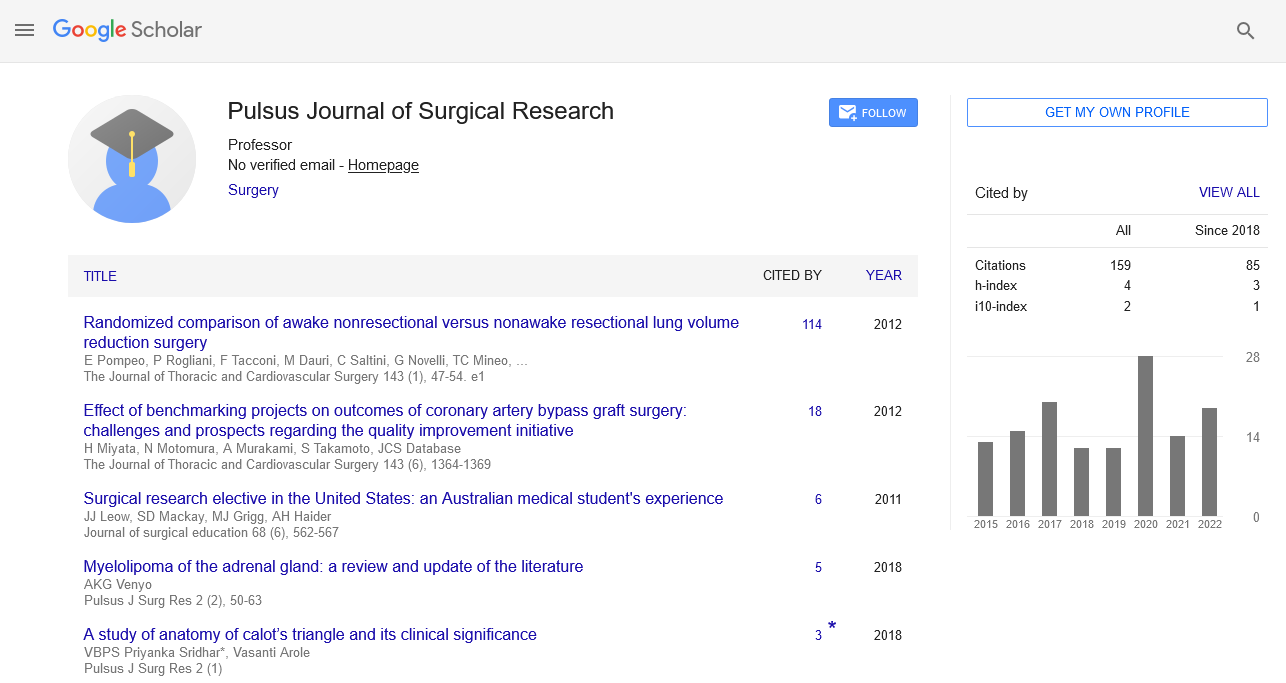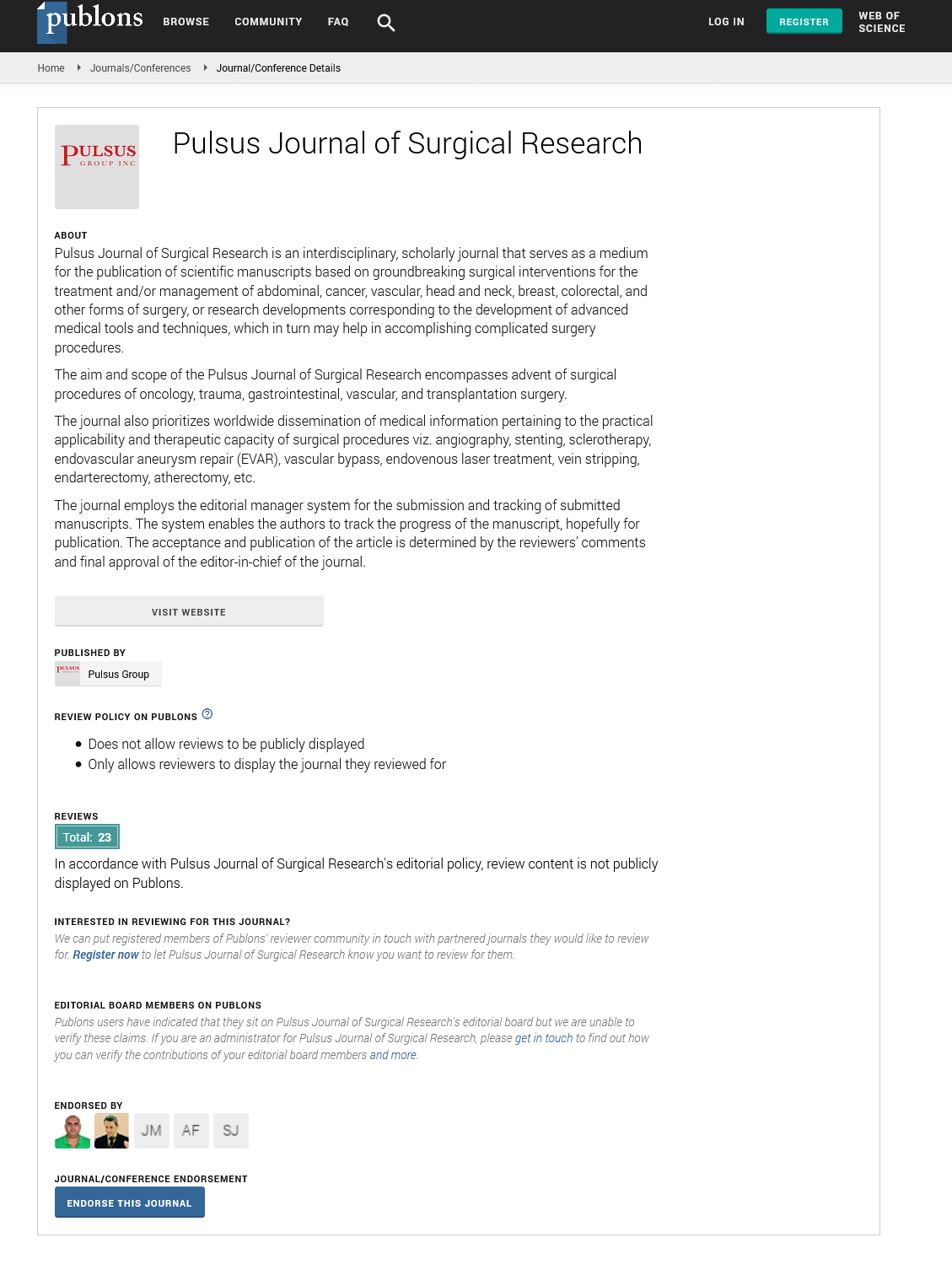Valve surgery needs a prolonged cardiopulmonary bypass and early estuation
Received: 03-Dec-2022, Manuscript No. pulpjsr- 22-5819; Editor assigned: 06-Dec-2022, Pre QC No. pulpjsr- 22-5819 (PQ); Accepted Date: Dec 26, 2022; Reviewed: 18-Dec-2022 QC No. pulpjsr- 22-5819 (Q); Revised: 24-Dec-2022, Manuscript No. pulpjsr- 22-5819 (R); Published: 30-Dec-2022
Citation: Airy A . Valve surgery needs a prolonged cardiopulmonary bypass and early estuation. J surg Res. 2022; 6(6):76-78.
This open-access article is distributed under the terms of the Creative Commons Attribution Non-Commercial License (CC BY-NC) (http://creativecommons.org/licenses/by-nc/4.0/), which permits reuse, distribution and reproduction of the article, provided that the original work is properly cited and the reuse is restricted to noncommercial purposes. For commercial reuse, contact reprints@pulsus.com
Abstract
Patients with brief cardiopulmonary bypass have primarily been investigated when early extubation occurs following cardiac surgery. It is still debatable whether preoperative spirometry can predict early extubation. To determine whether early extubation in valve surgery that requires prolonged cardiopulmonary bypass can be a goal and predicted by preoperative spirometry. Retrospective analysis of consecutive, non-emergent patients who underwent valve surgery. Patients who underwent early extubation spent less time in the intensive care unit and the hospital overall. Higher estimated glomerular filtration rates and mitral valve replacement were both significant protective factors for early extubatio, according to multivariate analysis. On the other hand, longer operations, cardiopulmonary bypass, and aortic cross-clamp times, as well as moderate and severe chronic obstructive pulmonary disease as determined by spirometry, were important risk factors. Current valve surgery should aim for early extubation. Spirometry before surgery.
Keywords
Surgical care; Virtual reality; Neuro surgery; Endocrine.
Introduction
To improve post-operative treatment following cardiac surgery with cardiopulmonary bypass, fast-track cardiac anesthesia is currently employed routinely. Successful early extubation of the trachea is a goal in this process. When surgery is over and the patient is in the intensive care unit (ICU), early extubation is typically described as the removal of the endotracheal tube. The success rate of early extubation is influenced by a variety of postoperative variables, and cardiopulmonary bypass time is well-known as a significant predictor of effective early extubation. After coronary artery bypass grafting (CABG), with a relatively short cardiopulmonary bypass period, the success rates of early extubation rates were typically documented in prior research, and this rate was published. However, because isolated CABG without CPB is performed off-pump, the EEx rates in these studies might not accurately represent those at those facilities. Following cardiac valve surgery, DMV is said to last longer than it does following typical isolated CABG. With fast-track management, the EEx rate following heart valve surgery was 64%; however, several individuals in this trial had undergone a very straightforward procedure, and high-risk patients and those who suffered post-operative adverse events were removed. Based on these findings, it is unclear whether successful EEx can reduce the length of ICU and hospital stay after cardiac valve surgery with a longer CPB time compared to after traditional CABG and whether patients handle it well. Chronic obstructive pulmonary disease has been identified in earlier research as a substantial risk factor for prolonged post-operative DMV, albeit many of these investigations did not include information on pre-operative respiratory performance. In large database systems, a diagnosis of the chronic obstructive pulmonary disease can be made without evaluating respiratory function. The European System for Cardiac Operative Risk Evaluation Score and the Society of Thoracic Surgery risk score. Between chronic obstructive pulmonary disease diagnosed based on medical history and chronic obstructive pulmonary disease diagnosed based on spirometry, there has been reported to be a considerable discrepancy. Spirometry performed prior to surgery may be crucial since it may be a predictor of surgical mortality. Currently, there is debate on the predictive utility of spirometry for DMV, and many facilities don't conduct routine pulmonary function tests before cardiac surgery. The main goal of the current study was to ascertain the EEx rate in patients who underwent heart valve surgery requiring a considerable amount of CPB time and to ascertain whether EEx was associated with shorter ICU and hospital stays without an increase in postoperative adverse events.
Studying the factors that indicate a successful EEx, notably spirometry readings and the ST’s extended intubation (ventilation) score, was the secondary goal. Hospital, consent waiver was obtained. The data constituted our contribution to the Japan Adult Cardiovascular Surgery Database and were prospectively entered into our database upon patient admission. We looked at a group of individuals who had CPB for non-emergency heart surgery at our facility.
All operations involved the cardiac valves since we do isolated CABG using an off-pump approach. Emergency heart valve surgeries took place throughout the same time frame and were therefore not included in this investigation. Circulatory arrest surgeries and isolated CABGs converted to on-pump procedures were not included in the study. All operations began in the morning and were carried out via a median sternotomy. The computations for the ascending aorta and biocidal created our standard CPB. All patients had antegrade and retrograde cold blood cardioplegia, which was used to produce and sustain cardioplegic arrest; warm blood cardioplegia was administered shortly prior to unclamping the aorta. It was never necessary to stop the circulation to the lower body or to selectively perfuse the brain. After trans esophageal echo evaluations of heart function and valve functioning, all of the patients were brought to the intensive care unit (ICU). The use of inotropic agents, transfusions, fluid/ volume replacement, and other treatments were all coordinated by a single group of ICU doctors
Prior to the patients being conscious and/or having their neurological status evaluated, anesthetic medications were not administered. Dexmedetomidine hydrochloride was occasionally given to patients after the neurological state was confirmed in order to achieve the proper analgesia and sedation. The ICU doctors extubated the patients who matched all of the requirements. Our extubation standards were in line with those of earlier research. However, this has often been examined following coronary artery bypass surgery with a very short CPB time. Successful EEx is aim to promote recovery after cardiac surgery, with both medical and economic benefits. Reported that in individuals who had undergone cardiac surgery, CABG was not a significant predictor of short DMV. Only a few studies have looked into whether EEx was advantageous for patients having heart valve surgery that required a lengthier CPB period. To the best of our knowledge, no other study has documented a CPB time that was longer than the one described in the current study. A number of high-risk patients were also included in this investigation. EEx was safe in these conditions and correlated with a shorter ICU and hospital stay. Patients in this study received double valve surgery as a group, endured additional procedures, and required a second aortic cross-clamp. Therefore, compared to prior studies on traditional isolated CABG, the mean surgical time, CPB duration, and aortic cross-clamping time in this study were relatively long. These timings may also be longer in a hospital where offpump CABG is commonly conducted. A CPB time more than was a major risk factor for post-operative extended ventilation,according to earlier investigations. The aortic cross-clamp time may have become a predictor of failed EEx because of extended CPB times, which may also be a major factor in prolonged DMV. A major predictor of failed EEx as well as CPB time was surgery time. The extended mechanical breathing increased surgical stress, and increased transfusion may all be contributing factors to this. In actuality, patients who received big transfusions needed longer surgeries than patients who received minimal transfusions. It is debatable if COPD is a predictor of EEx. In several studies, the diagnosis of COPD relied on the patient's self-report, so obtaining accurate results can be hampered by an incorrect pre-operative examination. In actuality, reports have been made of both a notable underutilization of pre-operative spirometry and a considerable underestimation of COPD in cardiac surgery.
In contrast, several studies have shown the influence of COPD grades on early clinical outcomes in cardiac surgery, despite the fact that they did not examine EEx. All non-emergency patients at our hospital participated in the current study without exception, and its effects on EEx were successfully identified. Grading of COPD is crucial since no/mild COPD has no impact on DMV, whereas moderate/severe COPD significantly affects DMV. It is known that patients with COPD have lower physiological reserves and are more susceptible to insults like major surgery and CPB, despite the fact that only a small number of studies have examined the mechanisms underlying the association between airway obstruction and postoperative morbidity and mortality. Due to the tight relationship between COPD and frailty, patients may have a delay in their recovery after surgical stress. Higher eGFR and mitral valve repair were found to be beneficial for EEx. In Gaur's study, individuals with mitral valve repair required much less time for intubation than those with mitral valve replacement. Why mitral valve repair may operate as a barrier to EEx is still a mystery. The need for more research is warranted. Reduced eGFR was found to be the biggest risk factor for the failure of EEx following cardiac surgery, according to Youssefi. Therefore, we think that GFR is particularly important for recovery following cardiac surgery. Bleeding has always been seen as a significant risk factor for delayed extubation in cardiac surgery, as has intra-operative transfusion (both RBC and FFP). Intra-operative transfusion was identified in the current study as a significant risk factor for delayed extubation by univariate analysis, however, multivariate analysis did not reveal this. Even when RBC and platelet transfusions (of any units) were independently analyzed, the outcome remained the same. Patients receiving intraoperative transfusion demonstrated significantly lower eGFR, a higher COPD grade, and a longer CPB time in our sub-analysis compared to patients without intraoperative transfusion. Clarifying the connections between these elements will require more research. Based on the results of our trial, we anticipate that good hemostasis at the conclusion of the procedure will enable EEx even in patients who experienced significant bleeding and transfusion throughout the procedure.
The present investigation further proved that post-operative adverse events have a considerable impact on post-operative DMV. However, only a small number of researchers have looked into the mechanisms underlying how post-operative adverse events affect the analysis of post-operative DMV predictors. In the current investigation, we verified that the same predictors were still found even after patients who experienced those events were excluded, showing that these predictors have a direct impact on the extubation criteria without creating any negative outcomes. Because kidney and lung function, operation duration, and CPB duration were predictors, post-CPB lung injury and/or delayed waking may be the causes of the delayed extubation. The postoperative DMV may reflect the fact that patients with EEx had superior pre-operative general health than patients without EEx. To learn how pre-operative general health or frailty affects the EEx rate, more research is required. EEx of patients without postoperative adverse events was not attained in the current study. We think the next area for practice and research will be to enhance perioperative care to raise the EEx rate. There were certain restrictions on this study. Even though all data were recorded into the database at the time of patient admission, because this was a retrospective analysis, underestimating adverse events may have had an impact on the findings. Second, we were unable to exactly compare our findings to those of earlier studies since we were unable to solely locate studies that exclusively addressed heart valve surgery. Third, despite the fact that we all worked as a team, followed the same guidelines, and spoke to each other often, perioperative management may not be the same for all patients. Last but not least, a single surgical team provided care to all patients, who were all Japanese by ethnicity, raising the possibility of team and racial bias.






